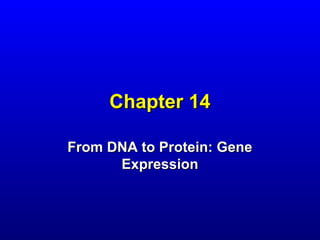
Chapter 14
- 1. Chapter 14 From DNA to Protein: Gene Expression
- 2. Gene Expression Path from a gene to a Gene expression occurs in two steps: phenotype Transcription “Central Dogma of Copies information from a Molecular Biology” DNA sequence (a gene) to a complementary RNA sequence DNA RNA Protein Translation Converts RNA sequence to amino acid sequence of a polypeptide
- 3. RNA RNA (ribonucleic acid) differs from DNA: • Usually one polynucleotide strand • The sugar is ribose • Contains uracil (U) instead of thymine (T)
- 4. RNA Bases in RNA can pair with a single strand of DNA, except that adenine pairs with uracil instead of thymine. Single-strand RNA can fold into complex shapes by internal base pairing.
- 5. Three Types of RNA Messenger RNA (mRNA) Carries copy of a DNA sequence to site of protein synthesis at the ribosome Transfer RNA (tRNA) Carries amino acids for polypeptide assembly Ribosomal RNA (rRNA) Catalyzes peptide bonds and provides structure
- 7. Transcription (DNA RNA) Transcription components: A DNA template for base pairings (one of the two strands of DNA) Nucleotides (ATP,GTP,CTP,UTP) as substrates RNA polymerase enzyme
- 8. RNA Polymerase • Catalyze the Synthesis of RNA • Do NOT need a primer to start synthesizing RNA • Do NOT have proofreading ability
- 10. Initiation RNA Polymerase binds to the target DNA at the promoter Unwinds a ~10bp bubble of the DNA to initiate transcription Transcription begins at the initiation site
- 11. Promoter Sequence of DNA where RNA polymerase binds Critical Regulation Point for the Flow of Genetic Information in the Cell Tells RNA polymerase “When, Where, How Much”
- 12. Elongation RNA polymerase unwinds DNA about ten base pairs at a time; reads template in 3′ to 5′ direction. The RNA transcript is antiparallel to the DNA template strand, and adds nucleotides to its 3′ end. RNA polymerases do not proofread and correct mistakes.
- 13. Elongation
- 14. Termination Is specified by a specific DNA base sequence (termination site). Mechanisms of termination are complex and varied. For some genes the transcript falls away from the DNA template and RNA polymerase (others require another protein to assist)
- 15. Following Transcription The completed mRNA leaves the nucleus through the nuclear pore Must interact with a ribosome to initiate translation Information encoded on the mRNA is the utilized to guide protein synthesis
- 16. Genetic Code Specifies which amino acids will be used to build a protein Codon: A sequence of three bases—each codon specifies a particular amino acid. Start codon: AUG Initiation signal for translation. Stop codons: UAA, UAG, UGA Stop translation and polypeptide is released.
- 17. Genetic Code 20 amino acids 64 different possible codons Codons are redundant Genetic Code is Universal
- 19. tRNAs Transfer RNAs act as the adapter between the mRNA and the growing polypeptide Must be “charged” or bound to a specific amino acid before they can be used in translation
- 20. tRNAs Clover leaf secondary structure Two important sites: Anticodon Binds to mRNA Amino Acid Attachment Site Binds to the respective amino acid
- 21. Ribosome The workbench that holds mRNA and charged tRNAs in the correct positions to allow assembly of polypeptide chain. Ribosomes are not specific, they can make any type of protein. Composed of a Large and Small Subunit
- 22. Large Subunit Three tRNA binding sites: A (amino acid) site binds with anticodon of charged tRNA P (polypeptide) site is where tRNA adds its amino acid to the growing chain E (exit) site is where tRNA sits before being released from the ribosome.
- 23. Small Subunit Has a fidelity function: When proper binding occurs, hydrogen bonds form between the base pairs.
- 24. Phases of Translation • Initiation • Elongation • Termination
- 25. Initiation Initiation Complex Forms 1) mRNA 2) Charged tRNA (bound to methionine) 3) Small subunit bound to the mRNA at the start codon
- 26. Initiation The large subunit then joins the complex; The charged tRNA is now in the P site of the large subunit.
- 27. Elongation The second charged tRNA enters the A site. Large subunit catalyzes two reactions: • It breaks bond between tRNA in P site and its amino acid • Peptide bond forms between that amino acid and the amino acid on tRNA in the A site
- 28. Elongation • The large subunit has peptidyl transferase activity • Critical to growing the polypeptide chain
- 29. Elongation When the first tRNA has released its methionine, it moves to the E site and dissociates from the ribosome—can then become charged again. Elongation occurs as the steps are repeated, assisted by proteins called elongation factors.
- 30. Termination Translation ends when a stop codon enters the A site. Stop codon binds a protein release factor— allows hydrolysis of bond between polypeptide chain and tRNA on the P site. Polypeptide chain separates from the
- 31. Post-Translational Modifications Proteolysis: Cutting of a long polypeptide chain into final products, by proteases Glycosylation: Addition of sugars to form glycoproteins Phosphorylation: Addition of phosphate groups catalyzed by protein kinases— charged phosphate groups change the conformation Leads to a mature and functional protein
